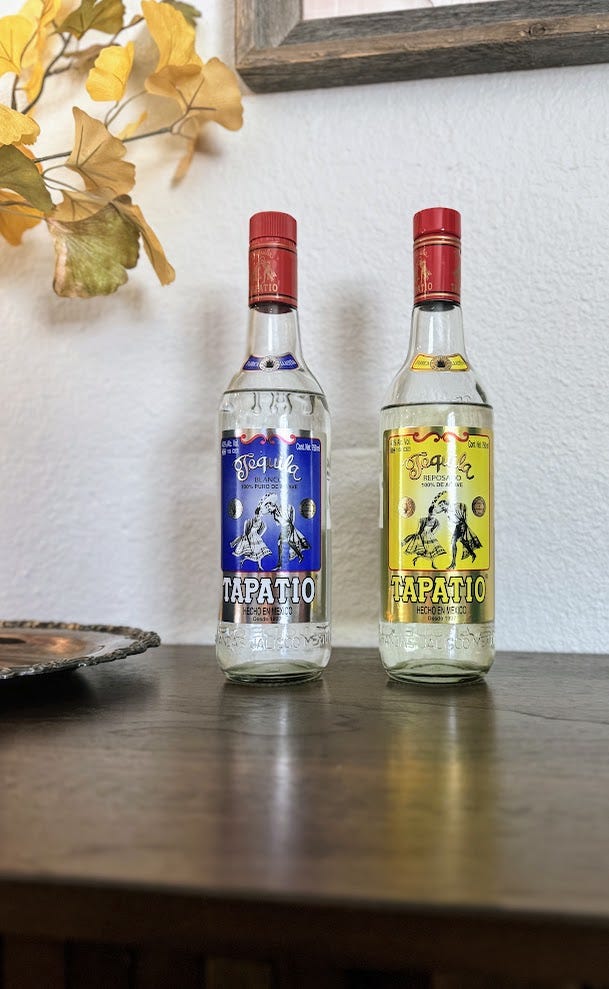Blanco vs Reposado
Tasting one brand's tequila expressions side-by-side and opining on their fitness for a marg
As I mentioned last week, I have somehow avoided developing strong allegiance to any particular brand of tequila. And as best I can tell, that makes me a bit of a unicorn in the population of spirits-drinking American men. And, I’m happy to report, that may be starting to change…
My best friend is fully Clase Azul-pilled, and while I enjoy it it’s too rich for my home bar (which is focused on cocktails, obviously, not neat sipping). My brother-in-law oscilates between Fortaleza (when he can find it, which is rare in the States these days) and Siete Leguas. I enjoy both of those quite a bit, but again they’re a bit rich for cocktails.
I was on the hunt for a brand that offered both blanco and reposado expressions at a ~$50 price point that isn’t exceptionally difficult to find in most stores. And I’ve finally discovered Tequila Tapatio, which is a true revelation. A Reddit post assured me that the quality was as high as the bottle is kitschy throwback, and their website that I don’t believe has been touched in over 5 years confirmed that these guys are the real deal.
In a world of fancy celebrity tequilas of dubious quality, this brand represents the antithesis. It doesn’t hurt that it shares a name (and nothing else) with my hot sauce of choice…
Tequila 101
First, a quick primer. Tequila is made from the blue agave plant in (mostly) Jalisco. If it’s any other agave plant (of which there are dozens, several of which grow in my yard) and/or (almost) any other Mexican state, it’s mezcal. If it’s not Mexican at all, it’s just “agave spirit.”
All tequila is mezcal, not all mezcal is tequila.
That’s what’s enforced by international law. What’s enforced by tradition is also a unique production process for the juice of the blue agave. I’m not going to go deep here, but the highlights of the unique process are:
Oven roasting of the agave centers vs pit roasting (leading to less smoke flavor)
Fermentation of the juice only instead of starting fermentation on the crushed and baked plants
Lack of distillation in clay pots, giving a more “finished” product along the lines of European spirits distilled in copper and/or stainless steel
Then, tequila is generally classified into 3 different buckets depending on how it’s treated once distillation is completed:
Blanco completely unaged, bottled directly from the still - it’s pure white, and it hasn’t touched wood
Reposado aged in wood for at least 2 months before bottling, but generally less than a year of aging (usually not stated by the brand)
Anejo aged in wood for at least a year, and often many many more (usually stated by the brand)
Since Anejo is a true aged spirit, it’s usually not called for in a margarita (daisy cocktails are almost always made with unaged spirits). And my house marg will follow those guidelines as well.
Tapatio Blanco
“Who do not enjoy Tapatío Blanco, could very well stop drinking tequila, because this is exactly what silver (blanco) tequila should be.”
That’s the kind of energy I want from my producer. For me, the nose here is heavy with lots of caramel - I smell age, even though there isn’t any age to smell. The brand says it’s herbal and spicy, with fruit and floral notes in a backseat. I smell the spices, especially clove.
The palate is exceptionally clean, and the age impression disappears. This is where I get the herbs, especially mint, and floral notes are strong as well. The brand says to expect a long finish, and they’re right, but it’s not necessarily a sweet one.
This is delicious, and I agree that with the brand that this juice really does highlight the essence of agave. I think it will go great in a margarita, with enough body to hold its own in the drink even without any age to help it.
Tapatio Reposado
The brand states that this has been “rested” for 4-6 months in Bourbon barrels before bottling, so I’d expect to smell even more caramel here. But, I don’t.
I do smell the wood directly, and there’s a lot of grass to go along with it. Frankly, I had to smell them side-by-side multiple times to make sure I wasn’t messing something up since these notes are the opposite of what I expected. The brand says to expect fruit, but I struggled to find it.
On the palate, the wood continues but gives way to fall fruits like apple and pear. The mouthfeel is a bit creamy, which makes sense, and that helps highlight some of the spice and nut character - especially cloves and almonds. The finish is quite a bit sweeter, but nowhere near cloying. It doesn’t seem to hold on as long, probably because it’s lower-proof (only 38% vs the “standard” 40%).
I think this would make a great margarita, and the brand agrees. But I worry a bit that some of the sweetness here will throw the drink out of balance and overpower the true agave characteristics you’re looking for.
Early Verdict
Without any testing, I’m leaning towards the blanco for my marg. It’s delicious alone, so it’s still a great neat option,


